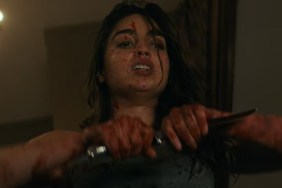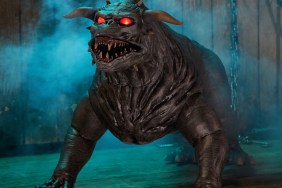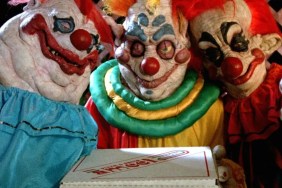Writer Jessica Ferri muses on one of the pre-eminent horror sub-genres: Slashers. It’s a stab-tastic tutorial with a feminist spin. Read on…
“Do you like scary movies?”
Most of us, even those who aren’t a huge fan of horror movies, know the killer’s question from Wes Craven’s epic 1996 love letter to the slasher genre, Scream. And frankly, many probably feel similarly to Sidney Prescott (Neve Campbell), in her response: “What’s the point? They’re all the same. Some stupid killer stalking some big-breasted girl who can’t act who is always running up the stairs when she should be running out the front door. It’s insulting.”

Luckily for horror fans, the Halloween season is about the only time of year when these uninitiated might sit down and watch a scary movie with you. In the long list of great “scary movies,” John Carpenter’s 1978 classic, Halloween, feels pretty appropriate, but the original Halloween is unusual as far as slashers go—ironic, considering the movie is considered one of the first—and best—of its genre. And while it has everything that Sidney railed against: a stupid killer, a big-breasted girl who can’t act, and another (non big-breasted girl) who is always running up the stairs when she should be running out the front door, it’s not the typical bloodbath that comes to mind when you think of horror movies.
That girl, running up the stairs and not the front door, is none other than Jamie Lee Curtis, by now the scream queen. Back in 1978, Curtis was virtually unknown, but Carpenter loved the idea of casting the daughter of Janet Leigh, who had appeared in Alfred Hitchcock’s Psycho as the doomed heroine Marion Crane. Though Hitchcock’s most well-known film had shocked audiences eighteen years before, when you compare the two films side-by-side, it’s fascinating that as far as blood goes—you know, actual slashing—Psycho, the black-and-white thriller made in 1960, has more of it than Halloween, still largely considered one of the scariest slashers ever made. Carpenter said that he purposefully wanted to shoot in near darkness because to him, the audience imagining what was happening – rather than seeing it onscreen – was scarier.
Even as early as middle school, I had a reputation for showing scary movies at slumber parties. At that time I thought I got a kick out of scaring my friends to walk from the living room into the kitchen to get a glass of water because it reminded them too much of Casey’s (Drew Barrymore’s) house in Scream. I even at one point had the grand ambition to film my own version of Scream, with yours truly starring as Sidney, and a revolving cast of friends in all the supporting roles.

By now, if you’re the kind of horror buff that craves blood, goodness knows there are enough films out there to indulge you—the entire torture porn genre, for instance, would probably do the trick. Or, if you’re looking for something more artful, there are always the films of Dario Argento to get you high off the sight of that nearly radioactive pink blood. But a trip down memory lane to the early slashers reveals one of horror’s greatest gifts: the birth of the Final Girl.
Thanks to Carol Clover’s excellent 1992 book, Men, Women, and Chainsaws, we have the definition of the Final Girl, and the argument as to how horror films are more complex in their experience of gender than we (or Sidney Prescott, for that matter) give them credit for.
In Psycho, when Marion’s sister Lila Crane (Vera Miles) survives Norman/Mother’s attack, it is thanks to Sam, who is able to grab him before he can strike. Since then, Clover writes, the Final Girl has absorbed the other two roles (Sam, the protector, and Arbogast, the investigator) to form one wholly competent main character. It’s worth pointing out that even now, in 2016, the fully-formed female protagonist that you’ll meet in horror movies is a more substantial part than most roles for women in film, who are often relegated to girlfriends, wives, or mothers.
“The Final Girl . . . she alone looks death in the face,” Clover writes. “From 1974 on, the survivor figure has been female. Given the drift in just four years between ‘Texas Chainsaw’ and ‘Halloween’—from passive to active defense—it is no surprise that the films following ‘Halloween’ present Final Girls who not only fight back but do so with ferocity and even kill the killer on their own, without help from the outside.”

Lila Crane’s Final Girls in arms include Jess Bradford (Olivia Hussey) in Black Christmas, Laurie Strode (Jamie Lee Curtis) in Halloween, Sally Hardesty (Marilyn Burns) in Texas Chainsaw Massacre, Ginny Field (Amy Steel) in Friday the 13th Part II, Nancy Thompson (Heather Langenkamp) in the Nightmare on Elm Street series, Ellen Ripley (Sigourney Weaver) in Alien, and of course, Sidney Prescott in Scream. There are also wonderful movies like 1978’s I Spit on Your Grave, 1983’s Sleepaway Camp, 2003’s High Tension, and 2013’s Evil Dead, that invert gender and the idea of the final girl in wonderful ways. The list just goes on and on.
Looking back on it, I think I loved slashers because of the Final Girl, even though at the time I didn’t have a name for her. I loved how horror’s Final Girl had to be smart, so she could outwit the killer. She also had to be brave, and physically strong. I also admired her moral courage. The Final Girl was a virgin, who placed her schoolwork and friendships above boys and parties. The one-dimensional bimbos of teen rom-coms paled in comparison. I wanted to share with my friends that women could be heroes, too. Scaring them was just the icing on the cake.
So before you relegate slasher movies to the trash heap, it’s worth re-watching the classics that defined the genre and gave us our beloved Final Girls. It might be Halloween, but for horror fans, it feels an awful lot like Christmas. The slasher flick is the gift that keeps on giving.









